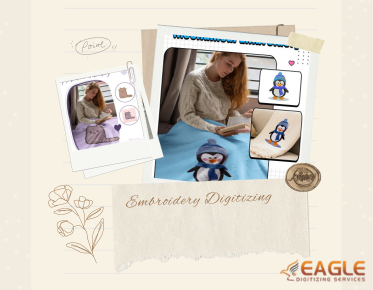The Revolutionary Impact of Embroidery Digitizing on the Industry
A Shift in the Embroidery Industry
The advent of embroidery digitizing has indeed revolutionized the embroidery industry. Most would agree that this technology has not only made the process more efficient but also reduced the workload for artisans and businesses alike. Before this technological breakthrough, embroidery was a meticulous and time-consuming task, often fraught with errors and requiring painstaking attention to detail. With digitizing, however, these challenges have been significantly minimized, bringing great ease to the industry.
How Embroidery Has Changed Over Time
If you reflect on traditional embroidery, it’s easy to imagine scenes from the past—your grandmother or other artisans stitching by hand, creating intricate designs over long periods. These masterful pieces were undoubtedly beautiful, but the process was slow, and one mistake could result in hours of rework or, worse, a complete restart. Such setbacks were not only disheartening but also time-consuming, especially for those without the stamina to endure this manual labor.
The Role of Technology in Modern Embroidery
Technological Aids in the 21st Century
In the 21st century, technology has simplified tasks across numerous industries, and embroidery is no exception. Modern technology has made the once laborious process of hand-stitching almost effortless. The embroidery digitizer is at the heart of this transformation, offering an efficient solution to traditional embroidery challenges. By automating much of the process, the embroidery digitizer eliminates the need for hours of handwork and offers precision that was previously unattainable.
How the Embroidery Digitizer Solves Problems
For those unfamiliar with embroidery digitizing, it may seem like a complex concept. However, the process is fairly simple once you understand the basics. Instead of stitching designs by hand, you can now send your design to an embroidery digitizing service provider. These experts will convert the design into a digital format that can be read by computerized embroidery machines. Once uploaded, the machine follows the digital instructions to create the design on the selected fabric. This eliminates the risk of human error and drastically reduces production time.
Understanding Embroidery Digitizing
What is Embroidery Digitizing?
Embroidery digitizing is the process of converting a hand-drawn or digital design into a format that can be read by embroidery machines. This transformation allows complex designs that would take months to embroider by hand to be completed in just a few hours. The embroidery digitizer bridges the gap between traditional craftsmanship and modern technology, offering unprecedented speed and accuracy in producing embroidered goods.
Advantages of Embroidery Digitizing
One of the greatest advantages of embroidery digitizing is its ability to handle complex designs. These patterns, which were once too intricate to stitch manually, can now be easily transferred to fabric. What once took months can now be completed within a day, thanks to the precision and efficiency of computerized embroidery. This not only saves time but also ensures a higher level of consistency in the final product.
How Embroidery Digitizing Works
From Design to Embroidery
The digitizing process begins with a traced or digital design. This design is then sent to an embroidery digitizing service provider, who converts the file into a format that a computerized embroidery machine can read. The computer reads these instructions and directs the embroidery machine to stitch the design onto the fabric. This process is not only faster than traditional methods but also far more accurate.
Fast and Efficient Process
The speed at which embroidery digitizing works is a game-changer for the industry. Designs that once required months of careful hand-stitching can now be completed in mere hours. The equipment follows the digital instructions with precision, creating beautifully embroidered fabrics with minimal human intervention. This method has made embroidery digitizing a popular choice for businesses looking to produce high-quality embroidered goods efficiently.
The Cost of Embroidery Digitizing
Affordability of Embroidery Digitizing Services
You might wonder about the costs associated with embroidery digitizing. While purchasing embroidery software and the necessary equipment can be expensive, there's an affordable alternative: outsourcing the digitizing process to service providers. Many online companies offer embroidery digitizing services at a fraction of the cost of buying your own machinery.
The Financial Considerations
Investing in embroidery digitizing software and equipment can be a hefty expense. For businesses just starting out or those looking to cut costs, outsourcing to a digitizing service is a far more economical solution. All you need to do is select your design, send it to the service provider, and they’ll digitize the file for you, making it machine-ready. This approach is not only cost-effective but also incredibly convenient, as you can avoid the high upfront costs of purchasing software and equipment.
Why You Should Consider Outsourcing Embroidery Digitizing
Convenience and Cost Efficiency
Outsourcing embroidery digitizing has become a popular choice for many businesses, primarily because it saves both time and money. There’s no need to invest in expensive software or equipment when reliable service providers are just a click away. You can simply send your design to a professional, and they will digitize it for you at an affordable price, allowing you to focus on other aspects of your business.
Fast Turnaround and Quality Results
Outsourcing your digitizing needs also offers a fast turnaround. Many service providers offer same-day or next-day delivery of your digitized files, enabling you to quickly begin the embroidery process. Plus, these professionals use the latest technology to ensure that your designs are digitized to the highest standards, ensuring a high-quality finished product.
Why Embroidery Digitizing is the Future
Combining Tradition with Technology
Embroidery digitizing has brought a wave of innovation to a traditional art form. By combining the artistry of hand-drawn designs with the efficiency of computerized embroidery machines, the embroidery digitizer has transformed the industry. This blend of tradition and technology has created opportunities for artisans and businesses alike, allowing them to produce detailed and high-quality products more efficiently than ever before.
A Must-Have for Businesses
For businesses in the embroidery industry, embracing embroidery digitizing is no longer optional—it’s essential. The speed, precision, and cost-effectiveness offered by digitizing give businesses a competitive edge, allowing them to meet the growing demand for high-quality embroidered products without sacrificing quality or increasing costs. If you're involved in the embroidery business, now is the time to explore embroidery digitizing services.
Conclusion: Why You Should Embrace Embroidery Digitizing
In conclusion, embroidery digitizing is not just a fast and cost-effective solution, but it also brings a level of precision and efficiency that was once unimaginable in the world of embroidery. With technology continuously advancing, the future of embroidery is bright, and digitizing is leading the charge. Whether you’re a hobbyist or a business owner, this is the technology that will allow you to take your embroidery work to the next level. Don’t waste time—find a quality service provider and start enjoying the benefits of embroidery digitizing today.
FAQs About Embroidery Digitizing
1. Is embroidery digitizing suitable for all types of fabrics?
Yes, embroidery digitizing can be used on various fabrics, although some materials may require special techniques or adjustments for optimal results.
2. How much does it cost to outsource embroidery digitizing?
The cost of outsourcing embroidery digitizing depends on the complexity of the design and the service provider. Prices are generally affordable, especially compared to the cost of purchasing the necessary equipment and software.
3. Can I digitize my own designs without professional help?
While it’s possible to purchase digitizing software and learn to digitize designs yourself, the process requires skill and experience. Many people prefer to outsource this task to professionals for better results.
4. What’s the turnaround time for outsourced embroidery digitizing services?
Many service providers offer quick turnaround times, often delivering the digitized design within 24-48 hours.
5. Are there any limitations to embroidery digitizing?
The main limitation is that highly intricate or small designs may require adjustments to be suitable for embroidery. However, a skilled digitizer can modify these designs to ensure high-quality results.



